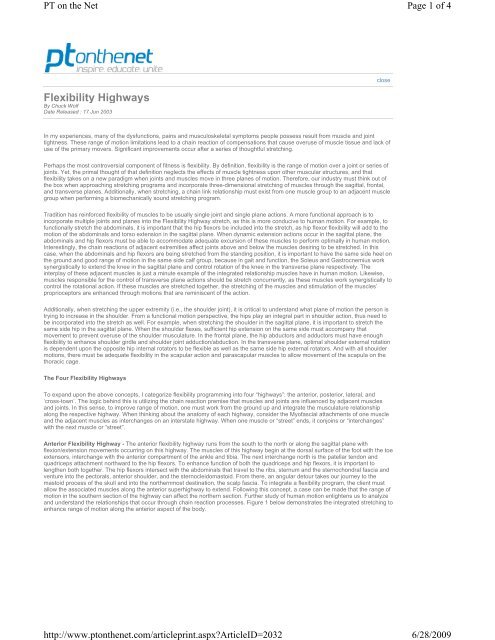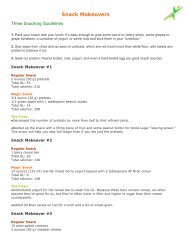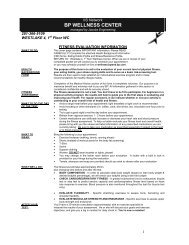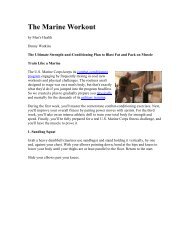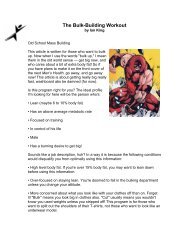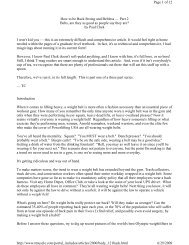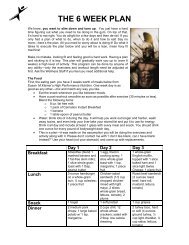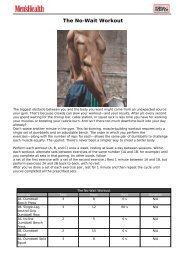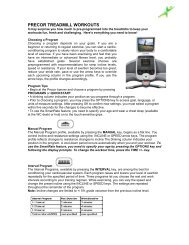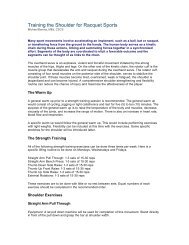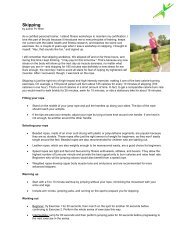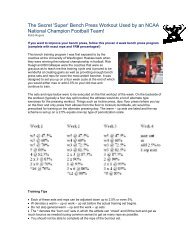Flexibility Highways - Trainingdimensions
Flexibility Highways - Trainingdimensions
Flexibility Highways - Trainingdimensions
Create successful ePaper yourself
Turn your PDF publications into a flip-book with our unique Google optimized e-Paper software.
PT on the Net<br />
http://www.ptonthenet.com/articleprint.aspx?ArticleID=2032<br />
Page 1 of 4<br />
6/28/2009<br />
close<br />
<strong>Flexibility</strong> <strong>Highways</strong><br />
By Chuck Wolf<br />
Date Released : 17 Jun 2003<br />
In my experiences, many of the dysfunctions, pains and musculoskeletal symptoms people possess result from muscle and joint<br />
tightness. These range of motion limitations lead to a chain reaction of compensations that cause overuse of muscle tissue and lack of<br />
use of the primary movers. Significant improvements occur after a series of thoughtful stretching.<br />
Perhaps the most controversial component of fitness is flexibility. By definition, flexibility is the range of motion over a joint or series of<br />
joints. Yet, the primal thought of that definition neglects the effects of muscle tightness upon other muscular structures, and that<br />
flexibility takes on a new paradigm when joints and muscles move in three planes of motion. Therefore, our industry must think out of<br />
the box when approaching stretching programs and incorporate three-dimensional stretching of muscles through the sagittal, frontal,<br />
and transverse planes. Additionally, when stretching, a chain link relationship must exist from one muscle group to an adjacent muscle<br />
group when performing a biomechanically sound stretching program.<br />
Tradition has reinforced flexibility of muscles to be usually single joint and single plane actions. A more functional approach is to<br />
incorporate multiple joints and planes into the <strong>Flexibility</strong> Highway stretch, as this is more conducive to human motion. For example, to<br />
functionally stretch the abdominals, it is important that the hip flexors be included into the stretch, as hip flexor flexibility will add to the<br />
motion of the abdominals and torso extension in the sagittal plane. When dynamic extension actions occur in the sagittal plane, the<br />
abdominals and hip flexors must be able to accommodate adequate excursion of these muscles to perform optimally in human motion.<br />
Interestingly, the chain reactions of adjacent extremities affect joints above and below the muscles desiring to be stretched. In this<br />
case, when the abdominals and hip flexors are being stretched from the standing position, it is important to have the same side heel on<br />
the ground and good range of motion in the same side calf group, because in gait and function, the Soleus and Gastrocnemius work<br />
synergistically to extend the knee in the sagittal plane and control rotation of the knee in the transverse plane respectively. The<br />
interplay of these adjacent muscles is just a minute example of the integrated relationship muscles have in human motion. Likewise,<br />
muscles responsible for the control of transverse plane actions should be stretch concurrently, as these muscles work synergistically to<br />
control the rotational action. If these muscles are stretched together, the stretching of the muscles and stimulation of the muscles’<br />
proprioceptors are enhanced through motions that are reminiscent of the action.<br />
Additionally, when stretching the upper extremity (i.e., the shoulder joint), it is critical to understand what plane of motion the person is<br />
trying to increase in the shoulder. From a functional motion perspective, the hips play an integral part in shoulder action, thus need to<br />
be incorporated into the stretch as well. For example, when stretching the shoulder in the sagittal plane, it is important to stretch the<br />
same side hip in the sagittal plane. When the shoulder flexes, sufficient hip extension on the same side must accompany that<br />
movement to prevent overuse of the shoulder musculature. In the frontal plane, the hip abductors and adductors must have enough<br />
flexibility to enhance shoulder girdle and shoulder joint adduction/abduction. In the transverse plane, optimal shoulder external rotation<br />
is dependent upon the opposite hip internal rotators to be flexible as well as the same side hip external rotators. And with all shoulder<br />
motions, there must be adequate flexibility in the scapular action and parascapular muscles to allow movement of the scapula on the<br />
thoracic cage.<br />
The Four <strong>Flexibility</strong> <strong>Highways</strong><br />
To expand upon the above concepts, I categorize flexibility programming into four “highways”: the anterior, posterior, lateral, and<br />
‘cross-town’. The logic behind this is utilizing the chain reaction premise that muscles and joints are influenced by adjacent muscles<br />
and joints. In this sense, to improve range of motion, one must work from the ground up and integrate the musculature relationship<br />
along the respective highway. When thinking about the anatomy of each highway, consider the Myofascial attachments of one muscle<br />
and the adjacent muscles as interchanges on an interstate highway. When one muscle or “street” ends, it conjoins or “interchanges”<br />
with the next muscle or “street”.<br />
Anterior <strong>Flexibility</strong> Highway - The anterior flexibility highway runs from the south to the north or along the sagittal plane with<br />
flexion/extension movements occurring on this highway. The muscles of this highway begin at the dorsal surface of the foot with the toe<br />
extensors, interchange with the anterior compartment of the ankle and tibia. The next interchange north is the patellar tendon and<br />
quadriceps attachment northward to the hip flexors. To enhance function of both the quadriceps and hip flexors, it is important to<br />
lengthen both together. The hip flexors intersect with the abdominals that travel to the ribs, sternum and the sternochondral fascia and<br />
venture into the pectorals, anterior shoulder, and the sternocleidomastoid. From there, an angular detour takes our journey to the<br />
mastoid process of the skull and into the northernmost destination, the scalp fascia. To integrate a flexibility program, the client must<br />
allow the associated muscles along the anterior superhighway to extend. Following this concept, a case can be made that the range of<br />
motion in the southern section of the highway can affect the northern section. Further study of human motion enlightens us to analyze<br />
and understand the relationships that occur through chain reaction processes. Figure 1 below demonstrates the integrated stretching to<br />
enhance range of motion along the anterior aspect of the body.
PT on the Net<br />
http://www.ptonthenet.com/articleprint.aspx?ArticleID=2032<br />
Page 2 of 4<br />
6/28/2009<br />
Figure 1 - Anterior <strong>Flexibility</strong><br />
Highway<br />
Posterior <strong>Flexibility</strong> Highway - The posterior flexibility highway runs from the south to the north or along the sagittal plane with<br />
flexion/extension movements occurring on this highway. The muscles of this highway begin at the plantar surface of the foot from the<br />
toe flexors through the posterior compartment of the ankle meeting at the Achilles tendon. Through the posterior calf group<br />
(Gastrocnemius, Soleus, and posterior tibialis) northward, the knee interchange meets the hamstrings. Taking the “hamstring<br />
expressway” to the ischial tuberosity, the gluteals and hamstrings create a multi-directional exchange north-by-northwest (or northeast<br />
depending upon which “leg” of the highway you travel) to the sacrolumbar junction. Here the gluteals meet the erector spinae, in<br />
‘lumbar fascia junction’, and head straight northward with many oblique interchanges of the spinal rotators along the way. It is important<br />
to note that the union of the gluteals and the erector spinae musculature should be stretched in an integrated fashion, as any functional<br />
lumbar movement pattern includes the gluteals and the relationship of these structures should be developed together. If the client<br />
wants to take a slight diversion through the rear shoulder group, a slight change of position and arm placement will include this area as<br />
well. Refer to Figure 2b below for this alternative route. The final posterior journey terminates at the scalp fascia. Figure 2a<br />
demonstrates the integrated stretching to enhance range of motion along the posterior aspect of the body.<br />
Figure 2a - Posterior <strong>Flexibility</strong><br />
Highway<br />
Figure 2b - Posterior <strong>Flexibility</strong><br />
Highway<br />
Lateral <strong>Flexibility</strong> Highway - Commonly overlooked in function is the lateral highway or column. The lateral flexibility highway runs<br />
from the south to the north along the frontal plane with abduction/adduction movements occurring on this highway. Running from the<br />
lateral ankle and the peroneal group the lateral highway goes north to the lateral tibial condoyle and the iliotibial band. Moving upward<br />
from this taut structure, the ITB merges with the tensor fascia lata, the gluteus medius and minimus, and meeting with the gluteus<br />
maximus. When analyzing the multi-directional fibrous “routes” of the gluteals complex, a point can be made to include these sections<br />
of the highways with all superhighway stretching. The gluteals are the “command central” of our center of gravity, balance, and power.<br />
They are utilized in all functional movement patterns, thus are the “hub” of tri-plane movement patterns. Along the lateral flexibility<br />
highway, the lateral gluteals are adjacent to the quadratus lumborum and then the obliques. The obliques merge with the external and<br />
internal intercostals toward the anterior aspect and the latissimus dorsi in the posterior aspect. From this point north, the lats will meet<br />
up with the posterior rotator cuff. A bypass occurs at the junction of the latissimus dorsi and the trapezius group, whereby the journey<br />
northbound excursions through the trapezius group to the sternocleidomastoid. As Figure 3 demonstrates, stretching the lateral<br />
highway is necessary for enhancement of frontal plane movement patterns. For the optimal lateral stretch, think from the bottom up<br />
and let the hip move laterally as far as it can without undue strain.
PT on the Net<br />
http://www.ptonthenet.com/articleprint.aspx?ArticleID=2032<br />
Page 3 of 4<br />
6/28/2009<br />
Figure 3 - Lateral <strong>Flexibility</strong><br />
Highway<br />
Cross-town <strong>Flexibility</strong> Highway - The cross-town flexibility highway runs from the south to the north along the transverse plane with<br />
rotational movements occurring on this highway. This highway produces the most power, is the most functional in movements and<br />
essentially affects the other three highways. The Cross-town is the most complex of the highway system because all routes can<br />
junction off from each other. When analyzing movement patterns, nothing is truly in only one plane of motion. There is influence from<br />
one plane into the other two, yet often one plane is predominant. The interesting phenomenon of the cross-town highway system is at<br />
each joint a junction to one of the other highways occurs. In describing this section, I will venture into the main junctions (i.e., the pelvic,<br />
abdominal, and shoulder intersections).<br />
From the navicular, cuneiform, and 2-4 metatarsals of plantar surface of the foot, the posterior tibialis enters upon the posterior<br />
compartment of the tibia. Also, the peroneus longus circles its wagons from the first metatarsal and medial cuneiform to the lateral<br />
fibular condyle and meets up with the biceps femoris. Additionally, the anterior tibialis from the first metatarsal comes around the bend<br />
to the lateral upper 2/3 of the tibia. Upward along the posterior tibia to the knee, the biceps femoris travels to the ischial tuberosity. The<br />
gluteals emanate in a tri-plane fashion and circle laterally to the gluteus medius and minimus and also the tensor fascia lata (TFL).<br />
Here the iliotibial band conjoins with the TFL. Interestingly, the peroneals meet the iliotibial band at the knee and create a distance<br />
relationship with the lateral hip complex (gluteals and TFL). From an opposite hip along the latissimus dorsi to the same side shoulder,<br />
the cross-town highway is heavily a factor in functional movements.<br />
On the anterior aspect, emanating from the gluteus medius, minimus and TFL, the cross-town highway travels along the obliques,<br />
abdominals, and pectorals to the opposite shoulder. This relationship must be established to enhance motions for throwing athletes as<br />
they “come over the top” in the throwing motion, and golfers upon the post-contact phase and follow-through in the golf swing. In these<br />
examples, the abdominals lengthen to decelerate relative spinal extension of the torso in relation to the hip. To reduce risk of injury,<br />
these muscle structures should be integrated together in a functional stretch. Additionally, the abdominals are the conduit between the<br />
hips and shoulder in the anterior flexibility highway. From the clavicular aspect of the pectorals and shoulder, the sternocleidomastoid<br />
then ends the journey as it conjoins with the mastoid process of the skull.<br />
Within the cross-town flexibility highway are smaller units of flexibility highways. The key routes are from the hips to the opposite<br />
shoulder on the anterior and posterior flexibility highways. Also, the gluteals and the opposite latissimus dorsi form a smaller unit of the<br />
cross-town flexibility highway. We must not forget the impact the lower extremities have upon the hips, back, and shoulders when<br />
integrating the flexibility highway stretches. It is very important to create the stretching relationship with these muscles groups to ensure<br />
the best and most functional highway connection for optimal performance.<br />
Figure 4a - Cross-town <strong>Flexibility</strong><br />
Highway<br />
Figure 4b - Cross-town <strong>Flexibility</strong><br />
Highway<br />
X-Factor: When the anatomy and fiber alignment of the gluteals is viewed, it is interesting to note the near<br />
parallel and continuous fiber highway of the opposite latissimus dorsi and gluteus maximus. I call this the<br />
posterior X-factor, and for this reason try to stretch these muscle groups together. For instance, when a<br />
right handed thrower decelerates the throwing motion, the left hip and gluteus maximus lengthen as well as<br />
the right latissimus dorsi and posterior shoulder. Another example is when a golfer takes their backswing;<br />
the opposite latissimus dorsi lengthens as well as the opposite gluteals. These muscles work in tandem to<br />
slow motion and therefore require to be stretched together in the cross-town highway, forming the X-Factor.<br />
For the anterior X-factor, I stretch the opposite hip flexor through the abdominals and obliques to the<br />
opposite shoulder. Therefore, I integrate those structures as these will be an enhancement for deceleration<br />
of functional movement patterns in the cross-town flexibility highway.<br />
The Hip Complex: One of the main junctions of the highway system is the hip complex due to the many<br />
muscles that converge in this region. As the above discussion states, there has been mergers from the<br />
anterior, posterior, and lateral highways in and around the hip. When looking at human motion, one can<br />
identify one highway that takes a bypass or junction and becomes motion and a necessitated stretch on the<br />
cross-town highway. The hip complex is one of those major junctions that must be stretched in all three<br />
planes of motion.<br />
Putting It All Together
PT on the Net<br />
http://www.ptonthenet.com/articleprint.aspx?ArticleID=2032<br />
Page 4 of 4<br />
6/28/2009<br />
When joints become immobile and the accompanying musculature becomes shortened and tight, the proprioceptors become desensitized<br />
and dysfunction can ensue. Joints become limited in motion, other structures will compensate to achieve the desired action.<br />
Studying human motion develops a deep appreciation for the myriad of intricacies that result from the relationship joints and muscles<br />
have upon each other. The three-dimensional interaction that occurs from the ground up through the body has tremendous impact<br />
upon optimal health and performance.<br />
Based upon the principles from the above discussion, controlled dynamic range of motion is useful for nearly all populations. The<br />
sedentary and deconditioned populations will benefit by movement patterns that will gradually lengthen muscle tissue through eccentric<br />
loading and simultaneously gaining strength. The client should move through the patterns gradually and increase range of motion with<br />
each repetition. By performing in this method, the person uses gravity, their body weight, body angles, moves in three planes of<br />
motion, and is able to improve activities of daily living. It is important to note none of these techniques are ballistic stretches, rather<br />
motions integrated into patterns that are task specific.<br />
A formula for effective range of motion improvement starts with gross movement patterns, such as 5-10 minutes of low level walking,<br />
jogging, cycling, or other activities the client enjoys and can tolerate. This is followed by tri-planar movement patterns that are task<br />
specific, starting with abbreviated motions that resemble the desired activity and gradually increase in depth of the range of motion.<br />
This will allow the lengthening of muscles, sensitize the proprioceptors, and enhance a greater range of motion.<br />
For the athletic population, the warm-up session should be task oriented to enhance tri-planar motions. With various movement<br />
patterns incorporating forward/backward, diagonal, rotational movements, lunges, jumps, and hops, a myriad of functional actions can<br />
enhance flexibility and not only increase range of motion, but prepare the athlete for participation and reduce risk of injury.<br />
After the workout session or event, it is advisable to then work on flexibility to lengthen muscles back to their resting state. I suggest<br />
holding the static stretch for 20-30 seconds and do each stretch twice. When doing static stretching, it should be multi-joint, multiplanar,<br />
utilizing multiple muscle groups. With this approach, the individual readies themselves for multi-dimensional motions for a<br />
lifetime.<br />
The excitement of studying the integrated motions and the relationship of joints to one another can provide the health and fitness<br />
professional an entirely new perspective on effective exercise programs. Just as important is the need for integrated flexibility programs<br />
to enhance the quality of life for all.<br />
References:<br />
1. Chain Reaction Explosion Seminar, Wynn Marketing, Adrian, Michigan, 2001<br />
2. Chaitow, Leon, Muscle Energy Techniques, 1996, New York, Churchill Livingstone<br />
3. Carlsoo, Sven, How Man Moves, 1972, London, William Heinemann Ltd.<br />
4. Clark, M.A., “Integrated <strong>Flexibility</strong> Training”, Thousand Oaks, Ca., National Academy of Sports Medicine, 2001<br />
5. Dykyj, Daria, Ph.D., “Anatomy of Motion”, Clinics in Podiatric Medicine and Surgery, July 1988, Vol. 5, No. 3<br />
6. DeMont, Richard, CAT©, Lephart, Scott,PhD, ATC, “Repetition Drives Neuromuscular Recovery after ACL Injury”,<br />
Biomechanics, April, 1998<br />
7. Gambetta, Vern, “Too Loose Too Much”, www.gambetta.com<br />
8. Gray, Gary, Total Body Functional Profile, Wynn Marketing, Adrian, Michigan, 2001<br />
9. Gray, Gary, P.T., “Pronation and Supination”, Wynn Marketing, Adrian, Michigan, 2001<br />
10. www.wynnmarketing.com,<br />
11. Gray, Gary, P.T., “Functional Biomechanics: Pure Definitions”, Wynn Marketing, Adrian, Michigan, 2001<br />
12. www.wynnmarketing.com,<br />
13. Inman, Verne, Human Walking, Williams & Wilkins, 1981<br />
14. Katch, Frank, Katch, Victor L., McArdle, William D., Exercise Physiology: Energy, Nutrition, and Human Performance, 1986,<br />
Philadelphia, Lea & Febiger<br />
15. Kurz, Thomas. (1994) Stretching Scientifically - a guide To <strong>Flexibility</strong> Training. Stadion Publishing Company, Inc. Island Pond,<br />
Vermont.<br />
16. Myers, Thomas, Anatomy Trains, Myofascial Meridians for Manual and Movement Therapists, 2001, Churchill Livingstone,<br />
New York<br />
17. Powers, Scott K. & Howley, Edward T., Exercise Physiology: Theory and Application to Fitness and Performance, 1990,<br />
Dubuque, Iowa, Wm. C. Brown Publishers<br />
18. Simon, Sheldon, MD, Mann, Roger, MD, Hagy, John, O.R.E., Larsen, Loren, MD, “Role of the Posterior Calf Muscles in<br />
Normal Gait”, Journal of Bone and Joint Surgery, June 1978, Vol. 60-A, No. 4<br />
close<br />
PTN Trainer Online | about PTontheNET | FitPro | Testimonials<br />
design: philter | development: sabukat


